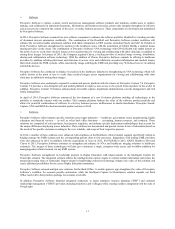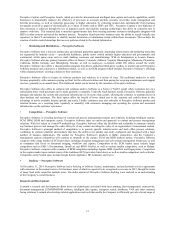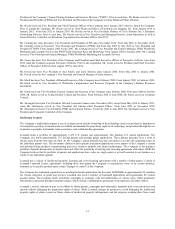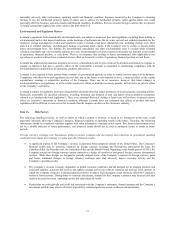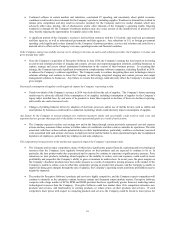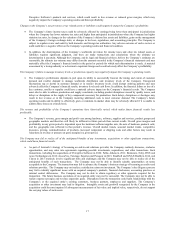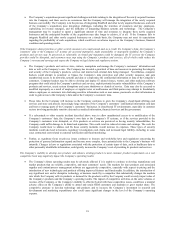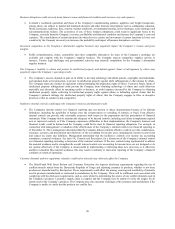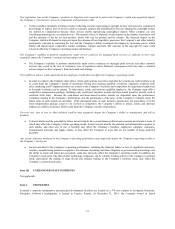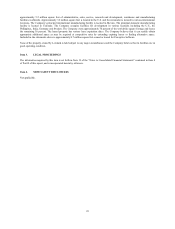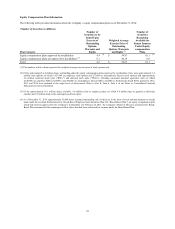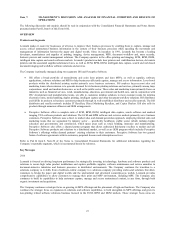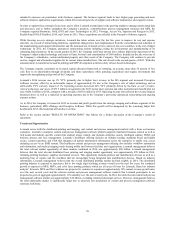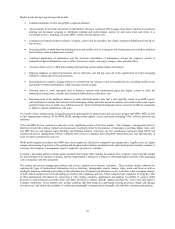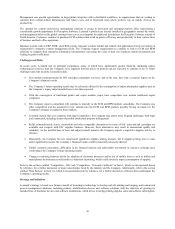Lexmark 2014 Annual Report Download - page 24
Download and view the complete annual report
Please find page 24 of the 2014 Lexmark annual report below. You can navigate through the pages in the report by either clicking on the pages listed below, or by using the keyword search tool below to find specific information within the annual report.Business disruptions could seriously harm future revenue and financial condition and increase costs and expenses.
Lexmark’s worldwide operations and those of the Company’s manufacturing partners, suppliers, and freight transporters,
among others, are subject to natural and manmade disasters and other business interruptions such as earthquakes, tsunamis,
floods, hurricanes, typhoons, fires, extreme weather conditions, environmental hazards, power shortages, water shortages and
telecommunications failures. The occurrence of any of these business disruptions could result in significant losses to the
Company, seriously harm the Company’s revenue, profitability and financial condition and increase the Company’s costs and
expenses. The consolidation of certain functions into shared service centers and movement of certain functions to lower cost
countries by the Company in recent year increases the probability and impact of business disruptions over time.
Increased competition in the Company’s aftermarket supplies business may negatively impact the Company’s revenue and gross
margins.
Refill, remanufactured, clones, counterfeits and other compatible alternatives for some of the Company’s cartridges are
available and compete with the Company’s supplies business. The Company expects competitive supplies activity to
increase. Various legal challenges and governmental activities may intensify competition for the Company’s aftermarket
supplies business.
The Company’s inability to obtain and protect its intellectual property and defend against claims of infringement by others may
negatively impact the Company’s operating results.
The Company’s success depends in part on its ability to develop technology and obtain patents, copyrights and trademarks,
and maintain trade secret protection, to protect its intellectual property against theft, infringement or other misuse by others.
The Company must also conduct its operations without infringing the proprietary rights of others. Current or future claims of
intellectual property infringement could prevent the Company from obtaining technology of others and could otherwise
materially and adversely affect its operating results or business, as could expenses incurred by the Company in obtaining
intellectual property rights, enforcing its intellectual property rights against others or defending against claims that the
Company’s products infringe the intellectual property rights of others, that the Company engages in false or deceptive
practices or that its conduct is anti-competitive.
Ineffective internal controls could impact the Company's business and financial results:
The Company's internal control over financial reporting may not prevent or detect misstatements because of its inherent
limitations, including the possibility of human error, the circumvention or overriding of controls, or fraud. Even effective
internal controls can provide only reasonable assurance with respect to the preparation and fair presentation of financial
statements. If the Company fails to maintain the adequacy of its internal controls, including any failure to implement required
new or improved controls, or if the Company experiences difficulties in their implementation, the Company's business and
financial results could be harmed and the Company could fail to meet its financial reporting obligations. For example, in
connection with management’s evaluation of the effectiveness of the Company’s internal control over financial reporting as
of December 31, 2014, management determined that the Company did not maintain effective controls over the completeness,
existence, accuracy and presentation and disclosure of the accounting for income taxes, including the income tax provision
and related tax assets and liabilities. Management determined that the ineffective controls over income tax accounting
constitutes a material weakness. See Item 9A, Controls and Procedures, for a discussion of the Company’s internal control
over financial reporting, including a discussion of the material weakness. If the new controls being implemented to address
the material weakness and to strengthen the overall internal control over accounting for income taxes are not designed or do
not operate effectively, if the Company is unsuccessful in implementing or following these new processes or is otherwise
unable to remediate this material weakness, this may result in untimely or inaccurate reporting of the Company’s financial
condition or results of operations.
Customer demands and new regulations related to conflict-free minerals may adversely affect the Company.
The Dodd-Frank Wall Street Reform and Consumer Protection Act imposes disclosure requirements regarding the use of
conflict minerals mined from the Democratic Republic of Congo and adjoining countries in products, whether or not these
products are manufactured by third parties. These requirements could affect the pricing, sourcing and availability of minerals
used in products manufactured or contracted to manufacture by the Company. There will be additional costs associated with
complying with the disclosure requirements, such as costs related to determining the source of any conflict minerals used in
the Company’s products. Lexmark’s supply chain is complex and the Company may be unable to verify the origins for all
metals used in the Company’s products. The Company may also encounter challenges with customers and stockholders if the
Company is unable to certify that the products are conflict free.
20



